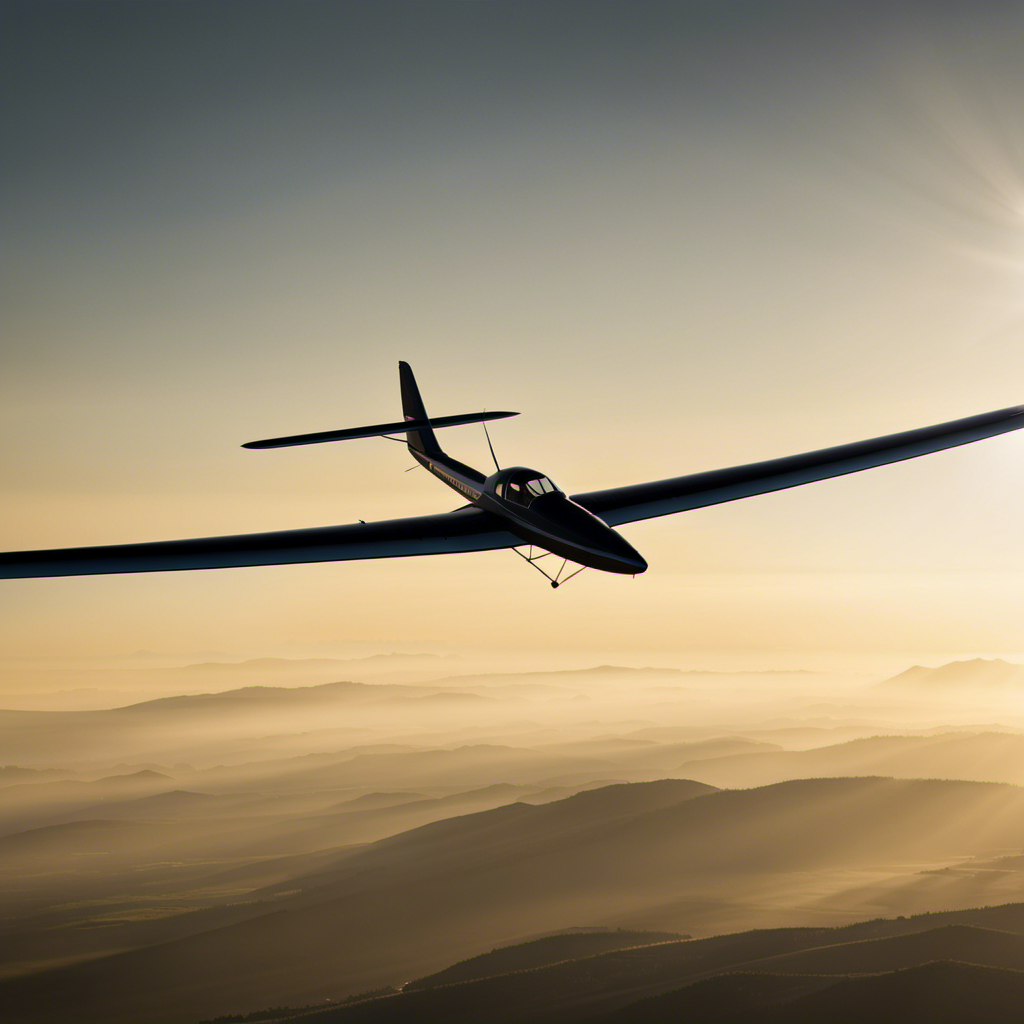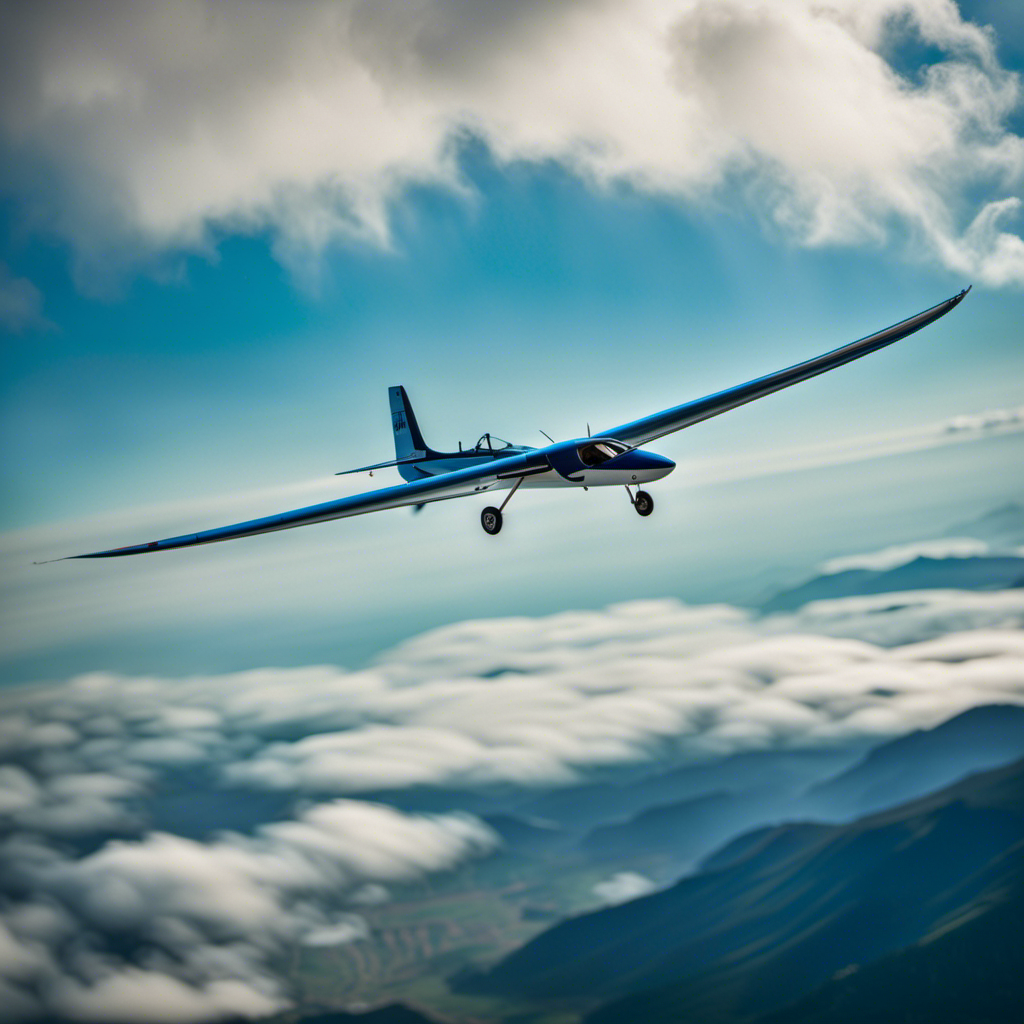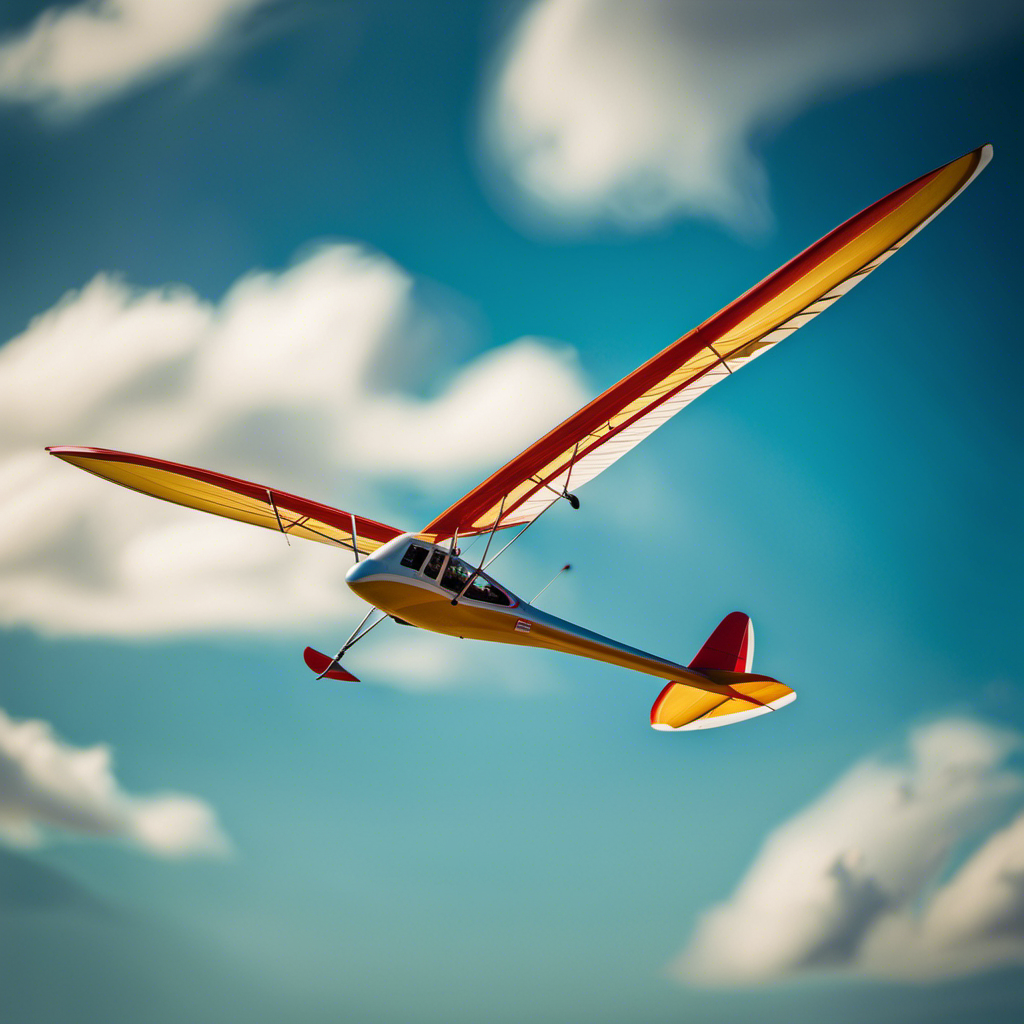Can you envision the feeling of gracefully soaring through the sky, driven only by the wind beneath your wings?
Well, imagine this: you’re gliding effortlessly above the clouds, guided only by your skill and the natural elements. That’s the exhilarating experience of flying a RES sailplane.
In this article, we will delve into the world of RES sailplanes, exploring their basics, the science behind soaring, and the exciting competitions that showcase the skills of these incredible aircraft.
So buckle up and get ready to embark on an incredible journey into the world of RES sailplanes.
Key Takeaways
- RES sailplanes are lightweight recreational flying aircraft with a wingspan of around 2 meters.
- They are made of durable materials such as fiberglass or carbon fiber.
- RES sailplanes have primary control surfaces including the rudder, elevator, and spoiler.
- Soaring in RES sailplanes involves utilizing thermals, ridge lift, wave lift, and convergence to gain altitude and prolong flight time.
The Basics of RES Sailplanes
RES sailplanes are designed for recreational flying and are popular among beginners. These sailplanes are lightweight and have a wingspan of around 2 meters. They are typically made of fiberglass or carbon fiber, which makes them strong and durable.
RES stands for rudder, elevator, and spoiler, which are the primary control surfaces of the sailplane. The rudder controls the yaw, the elevator controls the pitch, and the spoiler controls the glide path.
RES sailplanes are equipped with a high aspect ratio wing, which means they have a long and narrow wing shape. This allows them to generate lift more efficiently and stay in the air for longer periods of time.
Now, let’s explore the science behind soaring and how RES sailplanes utilize it to stay aloft.
The Science Behind Soaring
The science behind soaring is fascinating and involves understanding the principles of aerodynamics and thermals. Soaring is not just about gliding through the air; it’s about harnessing the power of the elements to stay aloft for extended periods. To give you a better understanding, let’s take a look at the key factors that contribute to successful soaring in a RES sailplane:
| Principles of Soaring | Factors |
|---|---|
| Aerodynamics | Wing shape, lift, drag, and weight distribution |
| Thermals | Rising columns of warm air caused by heating from the sun |
| Ridge Lift | Wind deflected upwards by a hill or mountain range |
| Wave Lift | Air currents caused by the interaction of wind with a mountain range or other obstacles |
| Convergence | Meeting of two or more air masses with different properties, creating lift |
Understanding these principles allows pilots to exploit the best conditions for soaring and maximize their flight time. Now, let’s explore the anatomy of a RES sailplane, which will give you a deeper insight into the components that make it a remarkable flying machine.
Anatomy of a RES Sailplane
Let’s take a closer look at what makes a RES sailplane a remarkable flying machine by exploring its anatomy.
-
Wingspan: The RES sailplane typically has a wingspan of around 2 meters, allowing for efficient lift and glide. The wings are designed with a high aspect ratio, providing optimal lift-to-drag ratio.
-
Fuselage: The fuselage serves as the main body of the sailplane, housing the cockpit and accommodating the pilot. It is aerodynamically shaped to minimize drag and improve performance.
-
Tailplane: The tailplane consists of the horizontal stabilizer and the elevator. It provides stability and control during flight. The elevator allows the pilot to adjust the pitch of the sailplane, facilitating maneuvers and maintaining stability.
Understanding the anatomy of a RES sailplane is crucial for successfully launching and flying one. By knowing how the wings, fuselage, and tailplane work together, you can optimize your flying experience and make the most of this incredible machine.
Launching and Flying a RES Sailplane
To launch and fly a RES sailplane, you’ll need to master the art of finding thermals and riding them to gain altitude.
Thermals are columns of warm air that rise from the ground due to heating by the sun. As a RES pilot, your goal is to locate these thermals and position your sailplane within them to take advantage of the upward lift.
You’ll need to be attentive to visual cues such as soaring birds, cumulus clouds, and the feel of the air on your face. Once you’ve found a thermal, you can circle within it, gradually climbing higher and higher.
This skillful maneuvering requires precise control of your sailplane’s banking and turning. By honing your skills in finding and riding thermals, you’ll be well-prepared for RES sailplane competitions, where the ability to maximize altitude gains is crucial for success.
RES Sailplane Competitions
Competitors in RES sailplane competitions must demonstrate their ability to maximize altitude gains by skillfully finding and riding thermals. These competitions require a deep understanding of the dynamics of thermal lift and the ability to read the sky for clues on where to find them.
Pilots must hone their skills in detecting subtle changes in wind direction and speed, as well as recognizing cloud formations that indicate the presence of thermals. Once a thermal is detected, competitors must skillfully maneuver their sailplanes to gain the maximum lift and stay within the thermal as long as possible.
The ability to effectively utilize thermals is crucial in gaining an advantage over other competitors and achieving the highest altitudes. With this knowledge and experience, you can now move on to choosing the right RES sailplane for your needs.
Choosing the Right RES Sailplane
Now that you have learned about RES sailplane competitions, it’s time to delve into the process of choosing the right RES sailplane for your needs. With so many options available, it can be overwhelming to make a decision. However, by considering a few key factors, you can find the perfect sailplane that suits your flying style and preferences.
Here are some factors to consider when choosing a RES sailplane:
-
Wing Span:
-
Determine the ideal wing span based on your flying experience and the weather conditions you’ll typically encounter.
-
Keep in mind that longer wings provide better lift and stability, while shorter wings offer increased maneuverability.
-
Construction Material:
-
Choose between a traditional balsa wood sailplane or a more modern carbon fiber construction.
-
Consider the trade-offs between weight, durability, and cost.
By carefully considering these factors, you can ensure that you choose a RES sailplane that will provide an enjoyable and rewarding flying experience.
Now that you have selected your sailplane, let’s move on to safety and maintenance tips for RES sailplanes.
Safety and Maintenance Tips for RES Sailplanes
When maintaining your RES sailplane, it’s important to regularly inspect the control surfaces for any signs of damage or wear. Start by checking the wings, elevators, and rudder for any cracks, dents, or loose fittings. Pay close attention to the hinges and control horns, ensuring they are secure and functioning properly. Check the control cables for fraying or corrosion, and make sure they are properly tensioned.
Inspect the fuselage for any structural damage, such as stress cracks or bulges. Additionally, inspect the landing gear and wheel brakes for any signs of wear or damage. By conducting these routine inspections and addressing any issues promptly, you can ensure the safety and performance of your RES sailplane.
Now that you have learned about maintaining your sailplane, let’s explore the benefits of joining the RES sailplane community.
Joining the RES Sailplane Community
If you’re looking to connect with other RES sailplane enthusiasts, there are several clubs and organizations that cater to your interests. These groups provide a great opportunity to meet fellow enthusiasts, share knowledge and experiences, and even participate in organized events and competitions.
Additionally, there are numerous events and gatherings specifically designed for RES sailplane pilots, where you can showcase your skills, learn from others, and immerse yourself in the vibrant community.
Clubs and Organizations for RES Sailplane Enthusiasts
Joining clubs and organizations is a great way for you to connect with other RES sailplane enthusiasts. There are several clubs and organizations dedicated to RES sailplanes, such as the RES Sailplane Association and the RES Sailplane Group.
These groups offer a platform for you to meet fellow enthusiasts, exchange knowledge, and share experiences. By joining these clubs, you can participate in discussions, access resources, and stay up-to-date with the latest developments in the RES sailplane community.
Additionally, these clubs often organize events and gatherings for RES sailplane pilots, where you can meet other pilots, fly together, and learn from experienced individuals. These events provide a unique opportunity for you to immerse yourself in the RES sailplane community, learn new techniques, and build lasting friendships.
Events and Gatherings for RES Sailplane Pilots
Attending events and gatherings is a fantastic way for you to connect with other RES sailplane pilots and learn from their experiences. Here are four reasons why you should make it a priority to attend these events:
-
Networking: Events and gatherings provide a platform for you to meet and connect with other RES sailplane pilots. You can exchange knowledge, tips, and tricks, and even form lasting friendships.
-
Learning opportunities: These events often feature experienced pilots who are willing to share their expertise. You can attend workshops, seminars, and demonstrations to expand your knowledge and improve your skills.
-
Competition: Many events include friendly competitions where you can test your skills against other pilots. It’s a great way to challenge yourself and push your limits.
-
Community support: Being part of a community of like-minded individuals who share your passion for RES sailplanes can provide valuable support and encouragement.
Exploring RES Sailplane Destinations
If you’re looking for scenic locations to indulge in RES sailplane flying, there are plenty of options available.
From breathtaking mountain ranges to picturesque coastlines, these destinations offer stunning views to enhance your flying experience.
Additionally, there are resorts and airfields specifically equipped with RES sailplane facilities, ensuring that you have all the necessary amenities and support for an enjoyable and convenient flying trip.
Scenic Locations for RES Sailplane Flying
There’s nothing quite like soaring over scenic locations in a RES sailplane. Whether you’re a seasoned pilot or a first-time flyer, the thrill of gliding through the air and taking in breathtaking views is an experience like no other. From majestic mountains to picturesque coastlines, there are countless destinations around the world that offer the perfect backdrop for RES sailplane flying. Take a look at the table below to discover some of the most popular scenic locations for RES sailplane enthusiasts:
| Location | Description | Best Time to Visit |
|---|---|---|
| Alps, Europe | Magnificent mountain ranges | Spring and Summer |
| Great Barrier Reef, Australia | Stunning coral reefs and turquoise waters | Year-round |
| Grand Canyon, USA | Vast canyon with unique geological formations | Spring and Fall |
These locations not only provide stunning views, but also offer favorable weather conditions for RES sailplane flying. So why not plan your next adventure and enjoy the beauty of these scenic locations from above? In the upcoming section, we will explore resorts and airfields with RES sailplane facilities, allowing you to make the most of your flying experience without missing out on any luxurious amenities.
Resorts and Airfields with RES Sailplane Facilities
The resorts and airfields with RES sailplane facilities offer a range of luxurious amenities for enthusiasts to enjoy. These exclusive locations provide a haven for those seeking a combination of adventure and relaxation.
Immerse yourself in the breathtaking landscapes as you take to the skies in a state-of-the-art RES sailplane. Indulge in world-class dining options, unwind in spa retreats, or simply enjoy the serenity of nature surrounding you. These facilities cater to all your needs, ensuring a truly memorable experience.
As the popularity of RES sailplanes continues to soar, these resorts and airfields are constantly evolving to meet the demands of the future. The advancements in technology and design promise an exciting future for RES sailplanes, opening up new possibilities for enthusiasts to explore the skies in unparalleled comfort and style.
The Future of RES Sailplanes
In this discussion, we will explore the exciting developments in RES sailplane design that have been made possible through technological advancements.
These innovations have allowed for increased efficiency, performance, and safety in RES sailplanes, making them more accessible and enjoyable for pilots of all skill levels.
Additionally, we will delve into the growing interest and participation in RES sailplane flying, as more and more individuals are discovering the thrill and freedom of soaring through the skies in these remarkable aircraft.
Technological Advancements in RES Sailplane Design
Advancements in RES sailplane design have led to increased performance and efficiency. New technologies and materials have allowed for the creation of lighter, more aerodynamic sailplanes that can soar through the sky with ease.
The introduction of carbon fiber composites has significantly reduced the weight of the sailplane, improving its glide ratio and overall performance. In addition, advancements in wing design, such as the implementation of winglets, have reduced drag and increased lift, resulting in better energy efficiency.
The incorporation of advanced avionics systems has also enhanced the pilot’s ability to navigate and make informed decisions during flight. These technological advancements have revolutionized the RES sailplane industry, attracting a growing interest and participation in RES sailplane flying.
As more people discover the thrill and satisfaction of soaring through the air, the RES sailplane community continues to expand.
Growing Interest and Participation in RES Sailplane Flying
As more people discover the thrill of soaring through the air, interest in and participation in RES sailplane flying continues to grow. Here are three reasons why RES sailplane flying is becoming more popular:
-
Accessibility: RES sailplanes are designed to be affordable and easy to fly, making them accessible to a wider range of people. With their simplified control systems and lower costs compared to other types of sailplanes, more individuals are able to experience the joy of flying.
-
Competitive Sport: RES sailplane flying has gained recognition as a competitive sport. Pilots can compete in various events and contests, showcasing their skills and pushing the limits of their sailplanes. This competitive aspect adds excitement and motivation for both seasoned pilots and newcomers.
-
Environmental Consciousness: With increasing concerns about the environment, RES sailplane flying offers a sustainable way to enjoy aviation. These sailplanes rely solely on natural energy sources, such as thermal air currents, instead of using fuel. This eco-friendly aspect attracts individuals who want to engage in aviation while minimizing their carbon footprint.
Overall, the growing interest and participation in RES sailplane flying can be attributed to its accessibility, competitiveness, and environmental consciousness.
Frequently Asked Questions
Can RES sailplanes be flown in all types of weather conditions?
Yes, RES sailplanes can be flown in a variety of weather conditions. However, it is important to note that extreme weather conditions such as strong winds, heavy rain, or severe turbulence may restrict their operation.
What are the different types of launch methods for RES sailplanes?
There are three main types of launch methods for res sailplanes: aerotow, winch launch, and self-launch. Aerotow involves being towed into the air by a powered aircraft, while winch launch uses a winch to launch the sailplane. Self-launch allows the sailplane to launch independently using its own engine.
Are there any specific weight restrictions for RES sailplanes?
There are specific weight restrictions for RES sailplanes. These restrictions ensure that the sailplanes are within a certain weight range, allowing for optimal performance and safety during flight.
Can RES sailplanes be modified or customized to fit individual preferences?
Yes, RES sailplanes can be modified or customized to fit individual preferences. You can make changes to the wing design, fuselage shape, and control system to enhance performance or improve handling according to your liking.
What are some common challenges faced by RES sailplane pilots and how can they be overcome?
Common challenges faced by res sailplane pilots include limited visibility, turbulence, and unpredictable weather conditions. These can be overcome by practicing proper techniques, staying alert, and continuously improving skills through training and experience.
Conclusion
In conclusion, RES Sailplanes offer an exhilarating and efficient way to explore the skies. With their sleek design and advanced technology, these soaring machines allow you to glide effortlessly through the air, harnessing the power of the wind.
Whether you’re a seasoned pilot or a curious beginner, the RES Sailplane community welcomes you with open arms. Soar to new heights, seize the opportunity to experience the serenity of flight, and join the ranks of passionate RES Sailplane enthusiasts.
The future of RES Sailplanes is boundless, beckoning you to embark on an extraordinary adventure.
With a heart that soars as high as the skies, Aria, affectionately known as “Skylark,” is the driving force behind Soaring Skyways. Her journey into the gliding world began as a young dreamer gazing up at the soaring birds, yearning to experience the weightlessness and freedom they embodied. With years of experience both in the cockpit and behind the scenes, Aria’s commitment to the gliding community is unwavering.










